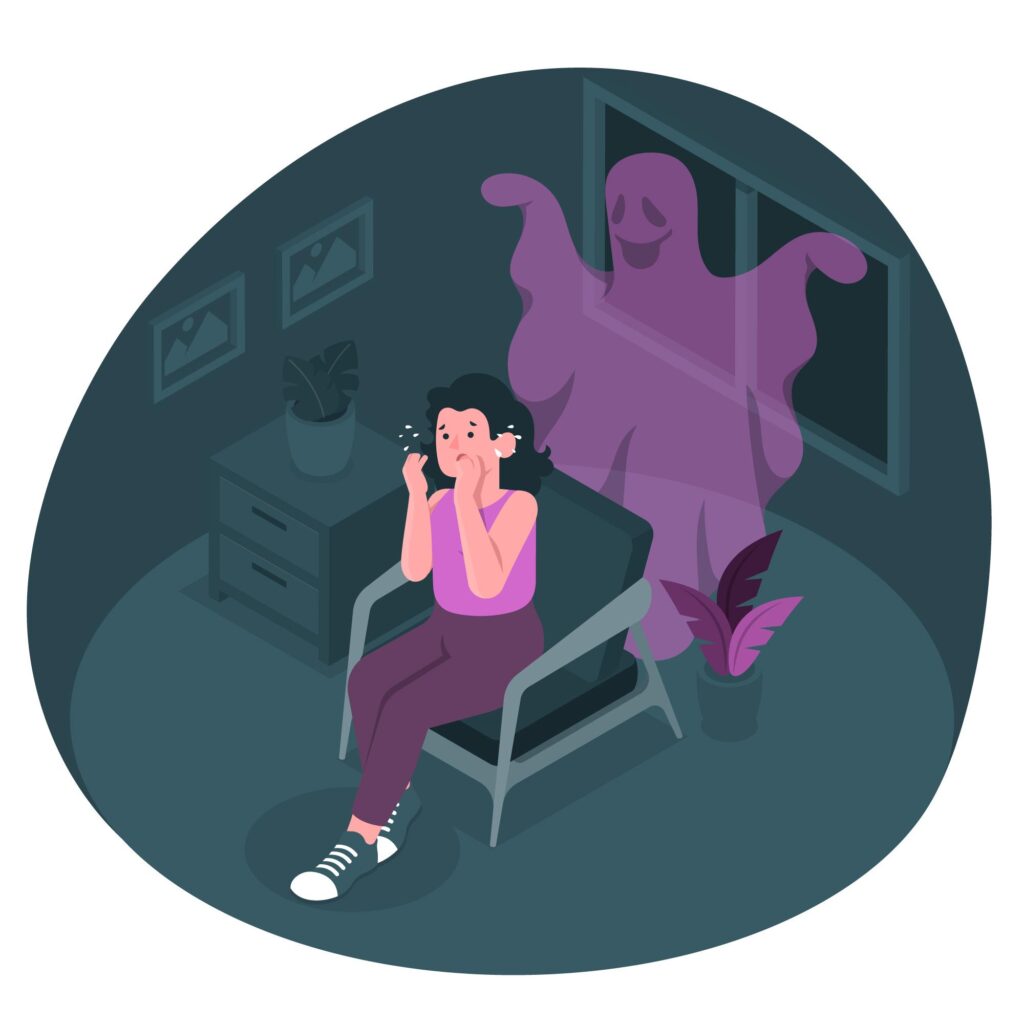What are phobias?
Phobias are intense and persistent irrational fears that primarily revolve around specific objects, situations, or activities. Unlike normal apprehensions, phobias cause significant distress and interfere with daily life. When confronted with the source of their fear, individuals with phobias experience a deep sense of dread or panic. Unlike general anxiety disorders, phobias are typically linked to something specific. Avoidance is a key factor in the behavioral patterns of phobias, leading to significant discomfort or dysfunction in individuals’ lives.
Understanding phobias
Fear and phobias are often used interchangeably, but there are significant differences between the two.
Fear is a natural protective response that all living beings experience. It serves to safeguard our lives and physical well-being. Fear is an emotional reaction triggered by a real or perceived threat, resulting in physical responses such as shaking or sweating.
On the other hand, phobias are a type of anxiety disorder. They are characterized by an irrational fear response to something that is not a threat. Phobias can elicit intense reactions, leading to impairment in daily functioning and activities. Even the mere thought of the feared stimuli can trigger symptoms of anxiety. The impact of phobias on a person’s life is referred to as impairment, which can range from mild to severe. A fear response can occur even in the absence of direct contact with the phobia-inducing stimuli.

Causes
Phobias can arise from various factors:
1. Genetic factors
Research suggests that genetic predispositions can contribute to the development of phobias. Certain genetic variations or traits within families may affect how the brain processes fear and stress. Specific genes linked to neurotransmitters like serotonin and dopamine, or those involved in regulating fear responses, could play a role. Variations in these genes may make individuals more susceptible to developing phobias when combined with environmental triggers or experiences. Studies involving twins, especially identical twins who share the same genetic makeup, have shown higher concordance rates for certain phobias compared to fraternal twins, supporting the influence of genetics.
2. Learned behaviors
Phobias can also develop through learned behaviours, primarily through a process called classical conditioning. For example, if someone experiences a traumatic event or intense fear associated with a particular object or situation (e.g., being trapped in an elevator during a blackout), they may associate that fear with the elevator itself, leading to a phobia. Observational learning is another way that learned behaviours contribute to phobias. If a person witnesses someone reacting fearfully to something, especially during childhood when learning is highly impressionable, they may adopt the same fearful response, resulting in the development of a phobia without having a direct negative experience. These learned behaviours shape our responses to specific stimuli, triggering intense fear or anxiety even in non-threatening situations. Over time, these associations become deeply ingrained, reinforcing the phobia.
3. Traumatic experiences
Traumatic experiences often serve as catalysts for phobias. When someone undergoes a deeply distressing event, it can leave a lasting imprint on the mind. Phobias frequently emerge from such experiences, especially when the trauma triggers an overwhelming fear response that associates certain stimuli or situations with danger. For example, surviving a dog attack might lead to cynophobia (fear of dogs). The brain forms a strong link between the traumatic event and the object or situation involved, resulting in an irrational and intense fear response upon encountering it again. This association can also be formed through witnessing or hearing about a traumatic event secondhand. Such experiences can profoundly influence the development of phobias and shape our responses to specific stimuli or situations, as the mind’s defence mechanism tries to protect against future harm by avoiding or fearing similar scenarios.
4. Childhood experiences
Childhood experiences play a pivotal role in the formation of phobias. Many phobias stem from distressing or traumatic events during childhood. For instance, a fear of dogs might originate from a childhood incident involving a dog bite or witnessing someone else being bitten. Similarly, being trapped in an enclosed space as a child might lead to claustrophobia later in life.
These experiences create associations between a specific stimulus and intense fear or danger. Such associations become deeply ingrained in the subconscious mind, leading to an exaggerated fear response when encountering similar situations or objects in the future. Childhood experiences shape emotional and cognitive responses, contributing to the development of phobias. Therapeutic interventions often involve revisiting and reframing these early experiences to help individuals reshape their perceptions and reduce the impact of childhood-rooted fears.
5. Cognitive factors
Cognitive factors play a significant role in the development and perpetuation of phobias. These factors involve thought processes, beliefs, and perceptions that contribute to the formation and maintenance of irrational fears. Cognitive biases, such as selective attention to threat-related information and catastrophic thinking, can amplify phobias. Individuals with phobias tend to focus selectively on potential threats, magnifying their perceived danger and reinforcing their fear response. Additionally, irrational beliefs, such as overestimating the likelihood of harm or feeling unable to cope with the feared situation, further perpetuate phobias.
6. Cultural factors
Cultural factors have a significant influence on the development of phobias. According to social learning theory, individuals acquire fears through observation and imitation. Cultural norms, beliefs, and experiences shape what is considered threatening or dangerous. For example, certain animals or natural phenomena may be associated with spiritual beliefs or superstitions in some cultures, leading to heightened fear responses. Cultural storytelling, media portrayals, and societal narratives can also reinforce specific fears. Phobias often arise from negative experiences or traumatic events associated with culturally significant objects or situations. Additionally, cultural taboos or rituals may unintentionally create or intensify fears.
Cultural practices also impact how phobias are expressed or managed. Some cultures may encourage seeking help and treatment for phobias, while others may emphasize self-reliance or traditional healing methods.
7. Environmental factors
Environmental factors play a significant role in the development of phobias. It often arise from experiences or learned behaviors within a specific environment. Classical conditioning is one key mechanism where a person associates a particular stimulus with fear due to a negative experience. For instance, if someone encounters a frightening event in a specific place or situation, they may develop a phobia related to that environment. Observational learning also contributes to environmental influences on phobias. Witnessing someone else experiencing fear or distress in a particular setting can instil similar apprehensions in an individual. This vicarious experience might lead to the formation of a phobia without a direct negative encounter.
Cultural and societal influences also contribute to environmental factors. Societies or communities that emphasize certain fears or reinforce specific ideas about dangers in particular environments may predispose individuals to develop corresponding phobias.
Different types
It can generally be classified into two categories:
- Specific phobias
- Complex phobias
Specific phobias
Specific phobias are intense, irrational fears of specific objects or situations, causing significant distress or impairment in daily life. Common triggers include animals, heights, needles, or flying. Individuals with specific phobias experience excessive anxiety when encountering their fear, leading to avoidance behaviors. These fears often stem from past experiences, genetics, or learned behaviors. Symptoms may include a rapid heartbeat, sweating, trembling, and a strong desire to escape the feared situation.
Complex phobias
Complex phobias encompass two primary types:
1. agoraphobia
2. social phobia.
Agoraphobia
Agoraphobia is an anxiety disorder characterized by an intense fear of situations or places where escape might be challenging or where help might not be readily available in case of a panic attack or other distressing symptoms. Individuals with agoraphobia often avoid crowded spaces, public transportation, open areas, or places where they might feel trapped or unable to leave easily. This fear can become debilitating, limiting daily activities and social interactions. People can develop agoraphobia after experiencing panic attacks, often fearing having a panic attack in situations where escape would be difficult or embarrassing.
Social phobia
Individuals with social phobia, also known as social anxiety disorder, intensely fear social situations where they might be scrutinized, judged, or embarrassed. It encompasses a persistent fear of social interactions, public speaking, meeting new people, or engaging in activities in front of others. Those with social phobia often experience extreme anxiety, leading to avoidance behaviors and distress that significantly disrupt daily life and relationships. This fear is not merely shyness, but a debilitating anxiety that can stem from past experiences, genetics, or learned behaviors.
Treatment options
The treatment for phobias primarily aims to improve your quality of life and assure you that your fears no longer limit you. By learning how to better manage responses, thoughts, feelings, anxieties, and fears, you can gain better control over your life.
1. Cognitive Behavioral Therapy (CBT)
Therapists commonly use Cognitive Behavioral Therapy to change thought patterns and behaviors associated with the phobia. Exposure therapy, a type of CBT, involves gradual exposure to the feared object or situation in a controlled environment.
2. Systematic desensitization
Systematic desensitization is another exposure therapy that involves progressively exposing individuals to their fears while teaching relaxation techniques to manage anxiety.
3. Virtual Reality therapy
Virtual Reality therapy uses VR simulations to expose individuals to their phobias in a controlled setting, allowing them to confront their fears gradually.
4. Mindfulness-Based Stress Reduction (MBSR)
Techniques involving mindfulness and meditation can help manage anxiety associated with phobias.
5. Hypnotherapy
In some cases, therapists use hypnosis techniques to access and address the subconscious roots of phobias.
6. Medications
Sometimes, doctors prescribe medications like anti-anxiety drugs or beta-blockers to alleviate symptoms associated with phobias. However, patients typically use these medications in conjunction with therapy.
Treatment efficacy varies based on the individual and the type of phobia. Combining therapies or tailoring approaches to suit personal needs often yields the best results. It is crucial to consult a mental health professional to determine the most suitable treatment plan.
A word to the readers
Living with phobias can be daunting, but remember, you are not alone. Do not let a phobia hold you back from living your best life. Seek support from professionals who specialize in treating phobias; therapy and exposure techniques can make a significant difference. Take small steps every day towards facing your fears and gradually challenging and desensitizing yourself. Self-compassion is crucial, so be patient with your progress and do not rush the process. Build a strong support network with friends and family who understand and support your journey. Finally, practice relaxation techniques like deep breathing or mindfulness to manage anxiety. With time, effort, and support, it is possible to overcome and live beyond the grip of phobias.
